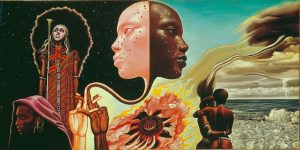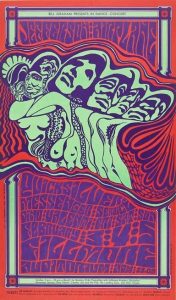Counter-culture is defined as “A way of life and set of attitudes opposed to or at variance with the prevailing social norm”[1] in the oxford dictionary.
Counter-culture of the 60’s was a time when people were standing up for rights and demanding equality and freedom. The Vietnam war started in 1955 and ended in 1975. The younger generation were protesting anti-war movements. African-Americans were fighting for equal rights and abolishing segregation.

Mati Klarwein, album art, Bitches Brew, 1970
On this album cover there’s a black lady and white lady connected at their heads and hands. Each side of the album cover has contrasting themes.
“For many, the sounds and images of Bitches Brew were intrinsically linked to the political climate, and specifically the racial climate of the early 70’s. The cover’s decidedly Afro-centric and psychedelic undertones reverberated within both the Black Power movement and the progressive counterculture of the early 70’s, but for different reasons.” (Ritchie, the-story-behind-mati-klarweins-bitches-brew-album-art, 2010).
The hippie movement in the 60’s and 70’s was considered Counter-Culture with the introduction of psychedelic art. Many people were using drugs. “The Psychedelic era was the time of social, musical and artistic change influenced by psychedelic drugs, occurring between the years of 1965–69[1] or the early 1960’s to the mid-1970’s” (Psychedelic_era, 2017). Below is an example of how psychedelic art was going against the social norm in terms of using “explicit” images to shock. The main reason it had a shock factor was because it was different and was challenging the ordinary.

Here is a photograph of Miles Davis, a famous Jazz musician. He was a key contributor to counter culture in the 60’s and 70’s. “Miles Davis was a major force in the jazz world” (miles-davis-9267992, 2017). Davis life style represented counter culture from the use of drugs, “In 1975, Davis was once again drawn into drug abuse, becoming addicted to alcohol and cocaine.” (miles-davis-9267992, 2017), to having album artwork Bitches Brew representing political change and peace, to pushing Jazz into the spotlight. “Bitches Brew soon became a best-selling album. As a result, Davis was featured on the cover of Rolling Stone magazine—becoming the first jazz artist to be so recognized” (miles-davis-9267992, 2017).
The use of sensibility and spirit combined with meaning as quoted by Paula Scher in the film (7’22”)[3] is all represented throughout counter culture through the different imagery.
Bibliography
miles-davis-9267992. (2017, September 22). Retrieved November 25, 2017, from www.biography.com: https://www.biography.com/people/miles-davis-9267992
Psychedelic_era. (2017, August 20). Retrieved November 25, 2017, from Wikipedia: https://en.wikipedia.org/wiki/Psychedelic_era
Ritchie, N. (2010, December 16). the-story-behind-mati-klarweins-bitches-brew-album-art. Retrieved November 25, 2017, from revive-music.com: http://revive-music.com/2010/12/16/the-story-behind-mati-klarweins-bitches-brew-album-art/
[1] https://en.oxforddictionaries.com/definition/counterculture
[2] http://www.denverpost.com/2014/10/09/denver-exhibit-turns-the-psychedelic-60s-into-the-stuff-of-museums/
[3] https://www.netflix.com/watch/80093802?trackId=13752289&tctx=0%2C0%2C994b385f0c6e8f96aebacce8cd12e6ef4f1c3d66%3Abcb5c97928642b8324169e7aa1bd3490de1e62ce

